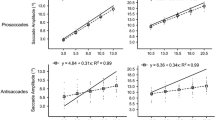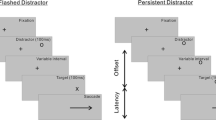Abstract
In the global effect, prosaccades are deviated to a position intermediate between two targets or between a distractor and a target, which may reflect spatial averaging in a map encoded by the superior colliculus. Antisaccades differ from prosaccades in that they dissociate the locations of the stimulus and goal and generate weaker collicular activity. We used these antisaccade properties to determine whether the global effect was generated in stimulus or goal computations, and whether the global effect would be larger for antisaccades, as predicted by collicular averaging. In the first two experiments, human subjects performed antisaccades while distractors were placed in the vicinity of either the stimulus or the saccadic goal. Global effects occurred only for goal-related and not for stimulus-related distractors, indicating that this effect emerges from interactions with motor representations. In the last experiment, subjects performed prosaccades and antisaccades with and without goal-related distractors. When the results were adjusted for differences in response latency, the global effect for rapid responses was three to four times larger for antisaccades than for prosaccades. Finally, we compared our findings with predictions from collicular models, to quantitatively test the spatial averaging hypothesis: we found that our results were consistent with the predictions of a collicular model. We conclude that the antisaccade global effect shows properties compatible with spatial averaging in collicular maps and likely originates in layers with neural activity related to goal rather than stimulus representations.








Similar content being viewed by others
References
Anderson RW, Keller EL, Gandhi NJ, Das S (1998) Two-dimensional saccade-related population activity in superior colliculus in monkey. J Neurophysiol 80:798–817
Arai K, Keller EL (2004) A distributed model of the saccadic system: simulations of trajectory variations produced by multiple competing visual stimuli. Conf Proc IEEE Eng Med Biol Soc 7:4692–4695
Arai K, Keller EL, Edelman JA (1994) Two-dimensional neural network model of the primate saccadic system. Neural Netw 7:1115–1135
Coeffe C, O’Regan JK (1987) Reducing the influence of non-target stimuli on saccade accuracy: predictability and latency effects. Vis Res 27:227–240
Coren S, Hoenig P (1972) Effect of non-target stimuli upon length of voluntary saccades. Percept Mot Skills 34:499–508
Deubel H, Hauske G (1988) The programming of visually guided saccades. In: Marko H, Hauske G, Struppler A (eds) Processing structures for perception and action. Verlag Chemie, Weinheim, pp 67–74
Deubel H, Wolf W, Hauske G (1984) The evaluation of the oculomotor error signal. In: Gale AG, Johnson FW (eds) Theoretical and applied aspects of eye movement research. North-Holland, Amsterdam, pp 55–62
Dorris MC, Olivier E, Munoz DP (2007) Competitive integration of visual and preparatory signals in the superior colliculus during saccadic programming. J Neurosci 27:5053–5062
Doyle M, Walker R (2001) Curved saccade trajectories: voluntary and reflexive saccades curve away from irrelevant distractors. Exp Brain Res 139:333–344
Eggert T, Sailer U, Ditterich J, Straube A (2002) Differential effect of a distractor on primary saccades and perceptual localization. Vis Res 42:2969–2984
Everling S, Dorris MC, Klein RM, Munoz DP (1999) Role of primate superior colliculus in preparation and execution of anti-saccades and pro-saccades. J Neurosci 19:2740–2754
Findlay JM (1982) Global visual processing for saccadic eye movements. Vis Res 22:1033–1045
Findlay JM (1997) Saccade target selection during visual search. Vis Res 37:617–631
Findlay JM, Gilchrist ID (1997) Spatial scale and saccade programming. Perception 26:1159–1167
Findlay JM, Brogan D, Wenban-Smith MG (1993) The spatial signal for saccadic eye movements emphasizes visual boundaries. Percept Psychophys 53:633–641
Glimcher PW, Sparks DL (1993) Representation of averaging saccades in the superior colliculus of the monkey. Exp Brain Res 95:429–435
Godijn R, Theeuwes J (2002) Programming of endogenous and exogenous saccades: evidence for a competitive integration model. J Exp Psychol Hum Percept Perform 28:1039–1054
Godijn R, Theeuwes J (2004) The relationship between inhibition of return and saccade trajectory deviations. J Exp Psychol Hum Percept Perform 30:538–554
Hallett PE (1978) Primary and secondary saccades to goals defined by instructions. Vis Res 18:1279–1296
Hallett PE, Adams BD (1980) The predictability of saccadic latency in a novel voluntary oculomotor task. Vis Res 20:329–339
He PY, Kowler E (1989) The role of location probability in the programming of saccades: implications for “center-of-gravity” tendencies. Vis Res 29:1165–1181
Herwig A, Beisert M, Schneider WX (2010) On the spatial interaction of visual working memory and attention: evidence for a global effect from memory-guided saccades. J Vis 10:8
Marino RA, Rodgers CK, Levy R, Munoz DP (2008) The spatial relationships of visuomotor transformations in the superior colliculus map. J Neurophysiol 100(5):2564–2576
McSorley E, Haggard P, Walker R (2005) Spatial and temporal aspects of oculomotor inhibition as revealed by saccade trajectories. Vis Res 45:2492–2499
Meeter M, Van der Stigchel S, Theeuwes J (2010) A competitive integration model of exogenous and endogenous eye movements. Biol Cybern 102:271–291
Mohler CW, Wurtz RH (1976) Organization of monkey superior colliculus: intermediate layer cells discharging before eye movements. J Neurophysiol 39:722–744
Munoz DP, Everling S (2004) Look away: the anti-saccade task and the voluntary control of eye movement. Nat Rev Neurosci 5:218–228
Munoz DP, Wurtz RH (1995a) Saccade-related activity in monkey superior colliculus I. Characteristics of burst and buildup cells. J Neurophysiol 73:2313–2333
Munoz DP, Wurtz RH (1995b) Saccade-related activity in monkey superior colliculus. II. Spread of activity during saccades. J Neurophysiol 73:2334–2348
Ottes F, van Gisbergen J, Eggermont J (1984) Metrics of saccade responses to visual double stimuli: two different modes. Vis Res 24:1169–1179
Ottes FP, Van Gisbergen JA, Eggermont JJ (1985) Latency dependence of colour-based target vs nontarget discrimination by the saccadic system. Vis Res 25:849–862
Ottes FP, Van Gisbergen JA, Eggermont JJ (1986) Visuomotor fields of the superior colliculus: a quantitative model. Vis Res 26:857–873
Robinson DA (1972) Eye movements evoked by collicular stimulation in the alert monkey. Vis Res 12:1795–1808
Sparks DL, Hartwich-Young R (1989) The deep layers of the superior colliculus. Rev Oculomot Res 3:213–255
Sparks DL, Mays LE (1980) Movement fields of saccade-related burst neurons in the monkey superior colliculus. Brain Res 190:39–50
Trappenberg TP, Dorris MC, Munoz DP, Klein RM (2001) A model of saccade initiation based on the competitive integration of exogenous and endogenous signals in the superior colliculus. J Cogn Neurosci 13:256–271
Van der Stigchel S, Theeuwes J (2005) Relation between saccade trajectories and spatial distractor locations. Brain Res Cogn Brain Res 25:579–582
Van der Stigchel S, Meeter M, Theeuwes J (2006) Eye movement trajectories and what they tell us. Neurosci Biobehav Rev 30:666–679
Van der Stigchel S, van Zoest W, Theeuwes J, Barton JJ (2008) The influence of “blind” distractors on eye movement trajectories in visual hemifield defects. J Cogn Neurosci 20:2025–2036
Van der Stigchel S, de Vries JP, Bethlehem R, Theeuwes J (2011) A global effect of capture saccades. Exp Brain Res 210:57–65
Van Gisbergen JA, Van Opstal AJ, Tax AA (1987) Collicular ensemble coding of saccades based on vector summation. Neuroscience 21:541–555
van Opstal AJ, van Gisbergen JA (1989) Scatter in the metrics of saccades and properties of the collicular motor map. Vis Res 29:1183–1196
Van Opstal A, Van Gisbergen JAM (1990) Role of monkey superior colliculus in saccade averaging. Exp Brain Res 79:143–149
van Zoest W, Van der Stigchel S, Barton JJ (2008) Distractor effects on saccade trajectories: a comparison of prosaccades, antisaccades, and memory-guided saccades. Exp Brain Res 186:431–442
Walker R, Findlay JM (1996) Saccadic eye movement programming in unilateral neglect. Neuropsychologia 34:493–508
Walker R, Deubel H, Schneider WX, Findlay JM (1997) Effect of remote distractors on saccade programming: evidence for an extended fixation zone. J Neurophysiol 78:1108–1119
Wurtz RH, Mohler CW (1976) Organization of monkey superior colliculus: enhanced visual response of superficial layer cells. J Neurophysiol 39:745–765
Wurtz RH, Richmond BJ, Judge SJ (1980) Vision during saccadic eye movements. III. Visual interactions in monkey superior colliculus. J Neurophysiol 43:1168–1181
Acknowledgments
This work was supported by CIHR grant MOP-81270 and presented at the European Conference on Eye Movements, Marseille, 2011. JB was supported by a Canada Research Chair.
Author information
Authors and Affiliations
Corresponding author
Rights and permissions
About this article
Cite this article
Viswanathan, J., Barton, J.J.S. The global effect for antisaccades. Exp Brain Res 225, 247–259 (2013). https://doi.org/10.1007/s00221-012-3366-3
Received:
Accepted:
Published:
Issue Date:
DOI: https://doi.org/10.1007/s00221-012-3366-3




